Electrician in a wooden house: diagrams + installation instructions
Wood is considered an environmentally friendly material for the construction of residential buildings, so it is not surprising that the demand for beautiful and comfortable houses made of timber or logs is not reduced. First of all, a residential building should be safe in terms of electrical installation.
It is important to understand how an electrician should be held in a wooden house. You need to know how to introduce and organize an electrical system so as not to harm the health of residents and ensure the safety of property. We have detailed all aspects of this issue.
Our article will familiarize you with the general requirements for wiring. We will talk about the methods of establishing an electric network in a house, the rules for arranging an electrical panel and how to install cables. All electrical work must be carried out in strict accordance with the fire safety standards we have submitted.
The content of the article:
General wiring requirements
The main difference between wooden houses and reinforced concrete and brick structures is a high degree of fire hazard. This means that increased requirements apply to the choice of electrical devices, cables and the conditions for their installation.
According to statistics, about 1/2 of the cases of fires or fires in wooden houses or in houses with wooden finishes is due to gross errors of electricians.
It is wrong to install the outlet, it is not enough to carefully connect the wires in the junction box, ignore the grounding rules, as there may be a fire, and after it a fire.
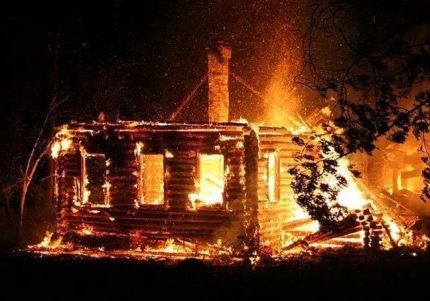
It is necessary to know the basic rules of electrical installation for two reasons: to be able to independently carry out part of the installation or repair work and to control the actions of unscrupulous “specialists”.
The following requirements should be remembered:
- Technical characteristics of cables and electrical equipment should maximally correspond to the power consumption of devices of each individual group.
- The operation of outlets, switches, emergency shutdown devices must be carried out taking into account the burden imposed on them.
- It is forbidden to use cables, wires, terminal connections during their regular heating.
- It is necessary to completely exclude the passage of fire from the cable to structures made of wood or other flammable materials using fireproof protection.
Wiring should be completely safe for home owners, their families (especially young children), and pets.
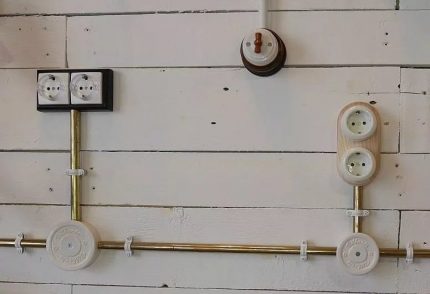
The material from the video reviews and instructions posted on the Internet is very controversial, so you should not fully rely on the opinions of people in overalls. You should focus on excerpts from the normative documentation - sections of the PUE, SNiPs, GOSTs.
Entering the power line into the house
In Russia and some other countries (unlike, for example, Europe, where the wires are hidden in the ground), electricity flows to consumers through overhead power lines - to the final support.
Then it is transmitted to users in three ways:
- self-supporting insulated wire (SIP);
- underground;
- on the cable (rarely used).
The first option is the most popular.
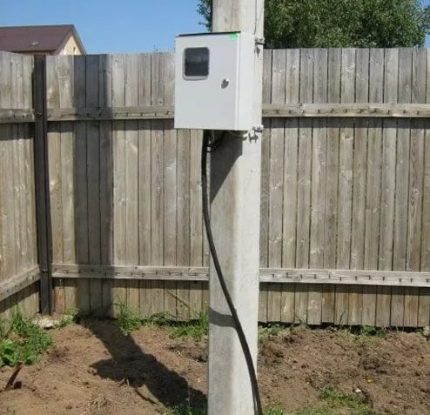
Together with the machine, electric power meters are also installed. Special boards (ЩУЭ) are intended for this purpose. According to the rules, ShchUE can be mounted drawer on the facade of the house, and inside the building, then the wiring diagram will change a little.
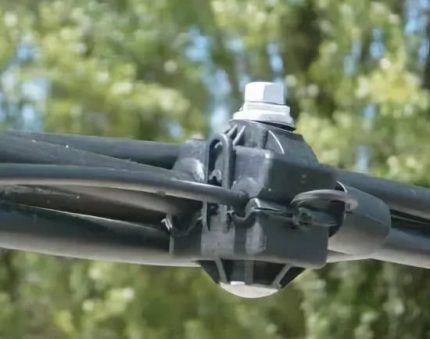
To insulate the wire running along the wooden surface, use fireproof boxes or corrugation for electrical wiring. The transition through walls and ceilings is carried out in protective sleeves made of metal, plastic analogues are unacceptable.
But it is recommended to use a polymer gasket on bends to protect the cable from wear. Plastic materials are treated with fire fighting solutions with flame retardants (for example, special paint).
Inside the house, SIPs do not start. According to standards, inside and on top of combustible structures it is possible to lay exclusively copper wires, therefore, aluminum analogues will also have to be excluded.
To choose cable for wiring in a wooden house, you need to pay attention to the type of insulation. The best options for a wooden house are recognized by VVGng and NYM.
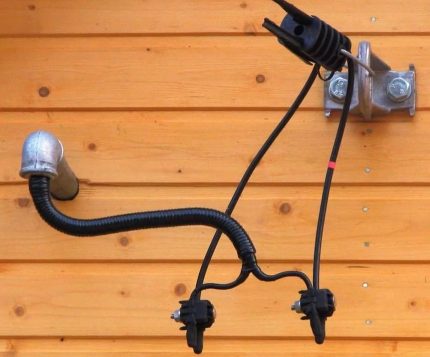
If the metering board is mounted on the facade, for example, at the request of the service company, then the self-supporting insulated wire is connected inside it to the machine, and then, up to the main switchboard - the distribution house switchboard - VVGng is pulled.
What to consider when laying the cable underground:
It is worth mentioning that the underground method of introducing an electric cable into a building is more expensive and more complicated than using SIP.
Features of the electrical panel device
Externally, the switchboard is a plastic or metal (which is preferable) box with a door with mounts for machines and an electricity meter.
It has no size restrictions, and when a new box is installed, they always leave a little free space for further connections.
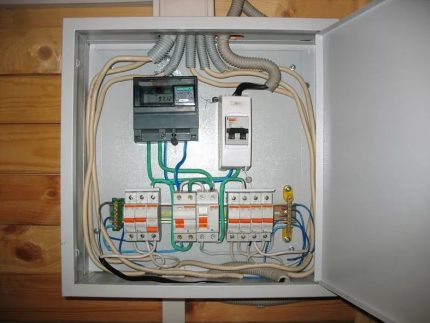
The circuit breakers are mounted on the DIN rails provided for this. Rated the value of automata directly depends on the parameters of the connected line: if the permissible limit of the outlet group is 16 A, then the machine must correspond to this value.
If there are automatic machines RCD optional, but installation should not be neglected. Additional protection is triggered when a leakage current occurs. Manually disconnect the RCD when it is necessary to shut off the flow of electricity into the house.
Despite the expensive cost of the equipment, responsible electricians insist on installing protection in zones, which increases the safe use of the power supply in a wooden house.
The nuances of connecting RCDs and machines in the dashboard are described in this article.
Rules for open wiring
The methods of open wiring should not contradict the requirements of the PUE.
Therefore, to attach cables to the wooden surface of walls, partitions or ceilings, the following products can be used:
- ceramic or porcelain insulators;
- floor skirting boards with integrated cable channel;
- corrugated and rigid PVC pipes;
- PVC box;
- metal boxes and pipes.
Specific names of products are indicated in the design documentation, and with respect to wooden structures, they must be accompanied by a fire safety certificate and be marked with the label "NG", as not supporting combustion.
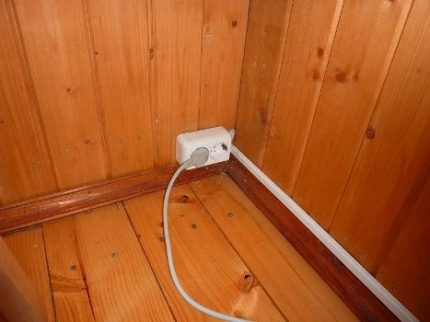
WITH choice of cable channels There are no questions, since in construction stores you can choose products by color and width, moreover, with a set of related accessories - plugs, rotary elements, adapters.
It is better to choose thick-walled, wide enough products with a single lock, since double-lock boxes are more difficult to maintain.
Installation requirements and recommendations:
- The cable, as well as protective fittings, must not support combustion, that is, it must be marked with "ng". The best option for wooden houses is VVGNG-ls (with low smoke emission).
- The presence of a metal platform for installation - a fireproof base that increases the safety of the use of electrical appliances.
- Switches and sockets - only overhead, outdoor.
- The use of metal sleeves to organize the transition of cable through wooden walls, floors, partitions.
Sleeve sleeves are pieces of thick-walled metal pipe that must protrude 1 cm on each side of the combustible structure. To prevent the cable from being deformed, the edges of the sleeves are protected with plastic overlays.
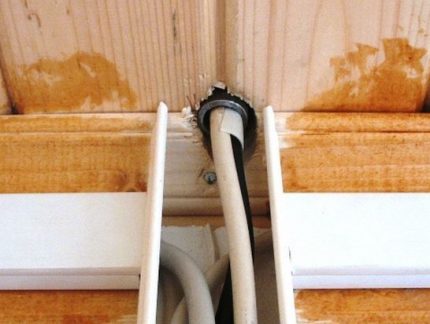
When choosing the cross-section of an electric cable for laying in a wooden house, they are guided by generally accepted norms:
- 3 * 2.5 mm - for sockets;
- from 6 mm² - for powerful electrical equipment, for example, electric stoves;
- 3 * 1.5 mm - for a lighting group, etc.
The formation of groups is carried out on the principle of "as little as possible", that is, a block of 4-5 outlets is allocated as a separate line and equipped with a separate machine.
Those who want to get rid of cables use open wiring on insulators. According to the PUE standards, it is allowed to place insulated wires in open form at a distance of 10 mm or more from a wooden surface.
The method, which was actively used back in the middle of the 20th century, is becoming fashionable again, so we will also pay attention to retro wiring.
Within a few years after the construction of the wooden house, it shrinks, so sagging wires is inevitable. To maintain a pleasant appearance of the lines without suspending, the wires are secured with cable ties above and below the insulators.
Additional information on open wiring is given in the article - Installation of open wiring: a review of the technology of work + analysis of the main errors
Wiring methods for closed wiring
The main difference between hidden wiring is the restriction on the use of laying methods.According to the PUE standards, more precisely, according to clause 7.1.38, all components of the wiring laid behind suspended ceiling systems in false walls made of drywall and boxes are equated to a hidden option for laying electrical networks.
Fire and electrical safety rules state that for hidden wiring, only two types of products can be used - a polymer electrical corrugation and a metal pipe or duct made of similar material, specially designed for this purpose.
Consider one example of the construction of electrical wiring in a country cottage:
To install switches and sockets, it is advisable to choose a fixed or inactive wall independent of the log house, for example, constructed of foam concrete blocks or drywall:
On the inside, the metal elements must be galvanized or painted so that they are not corroded during operation.
For a durable connection, a bell-shaped or similar method is not enough, therefore, soldering, electric welding, socket and threaded connections are used.
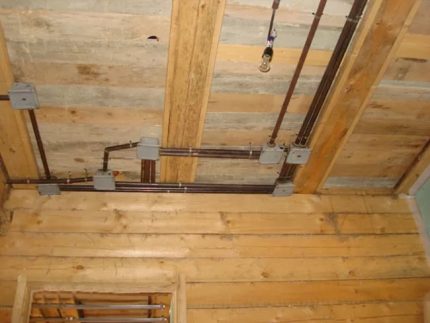
The use of metal hoses, corrugations and PVC boxes is also acceptable, but provided that the equipment is lined with a material that is not amenable to combustion: concrete, alabaster, plaster.
The main stages of laying closed electrical wiring:
- Road marking. It is necessary to calculate the length of the lines so that the number of turns and intersections is minimal.
- Wall and ceiling preparation. It includes hollowing out a strob, drilling holes.
- Laying of metal pipes. The size of the product is selected so that the cable occupies no more than half of the internal space.
- Mounting metal boxes under switches and sockets. Copper pipes are attached to the boxes by flaring, steel pipes with nuts.
- Installation of junction boxes. Ideally, they should be connected to the pipes by welding or soldering to ensure 100% grounding.
- Electrical measurements. All metal elements of the units must be connected to the PE bus (all lines without exception must be with a grounding conductor).
- Cable pulling into pipes. To put the wires inside the metal pipes, use special pull cables.
- Installation of sockets and switches. When cutting the cable, it is necessary to make a small supply of wires in case of repair or replacement of equipment.
After the electrical installation of the hidden wiring is completed, you must contact the representatives of the electric laboratory. Many people forget that a technical report on the status of wiring and the quality of installation is a mandatory document.

It should be understood that the installation of hidden wiring in steel, and even more so in copper pipes, is an unprofitable event from a material point of view.
In addition to expensive material, it is necessary to spend part of the money on good specialists, since a person who is far from wiring can not cope with the design of hidden wiring, and a qualified specialist is needed for installation.
Why do you need a ground loop
The design of electrical networks for a wooden house necessarily includes a section on the installation of the ground loop, without which the entire energy supply system to the building is considered unsafe. There are several ways to ground the device, and despite the prohibitions, all of them are still used.
You should refuse to assemble the circuit from improvised materials - this is dangerous. The traditional way of creating a “triangle” of metal corners and a tire requires free space in the house area, and since 2013 it has been banned as inappropriate to modern standards (GOST R 50571.5.54-2011).

It is reasonable to use a modular pin grounding method on a suburban area, according to which grounding conductors are installed in a line or around the perimeter of the house.
It does not require the allocation of impressive free space on the site, because all elements are located along existing objects. Only a hammer drill is needed to place the pin in the ground.
Steps for grounding device for a private house:
To increase the conductivity, factory-made electrodes are coated with copper, and all joints, threads and couplings are lubricated with conductive paste during assembly.
As a rule, paste also includes anti-corrosion additives. As a protection against aggressive environmental conditions, all connections are also wrapped with waterproofing material.
The advantages of prefabricated grounding systems of the pin type are efficiency, low labor costs, space saving, the main disadvantage is the high cost.
It is precisely because of the high cost that many owners of wooden cottages and country houses still use pieces of pieces of metal or reinforcement for ground loop devices instead of factory products.
Fire protection measures
If we analyze the entire process of electrical work in a wooden house from the point of view of safety, then we can distinguish the main rules:
- correct selection and installation of RCDs;
- installation of the ground loop in a modular pin manner (with a resistance of 4 ohms);
- potential equalization system device;
- ensuring continuity of grounding throughout the network;
- installation of overhead sockets only;
- flush mounting - in metal boxes and pipes.
At the end of the electrical work, the risks of accidental fire or electric shock, as well as the breakdown of household appliances due to unsatisfactory wiring conditions, should be completely eliminated.
Conclusions and useful video on the topic
In the process of laying routes and installing electrical installations, there are many nuances that only professional engineers and electricians will help to cope with.
How to install the socket using a wooden lining:
Hidden wiring rules:
General information about wiring in a wooden house:
Installation of the power grid in wooden structures that are considered combustible requires special attention, experience, knowledge of technical nuances and compliance with regulatory requirements.
For the preparation and approval of project documentation, the introduction of an electric cable into the house, as well as the installation of hidden wiring, we recommend contacting specialists. This does not interfere with working independently - for example, installing a power outlet.
If you have questions or have a desire to share personal experience in electrifying a wooden house, please leave comments on the article. The feedback box is located below.

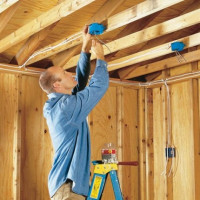 Wiring in a wooden house: design rules + step-by-step installation
Wiring in a wooden house: design rules + step-by-step installation 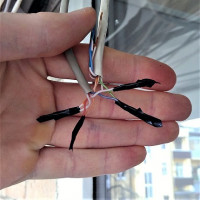 How to connect a twisted pair cable to each other: methods + instructions for building up a twisted wire
How to connect a twisted pair cable to each other: methods + instructions for building up a twisted wire 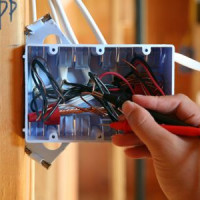 Which wire to use for wiring in the house: recommendations for selection
Which wire to use for wiring in the house: recommendations for selection 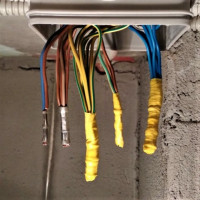 How to connect wires without soldering: the best ways and their features + installation recommendations
How to connect wires without soldering: the best ways and their features + installation recommendations 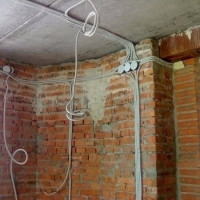 How to conduct wiring in the apartment with your own hands from the shield: basic schemes and rules + installation steps
How to conduct wiring in the apartment with your own hands from the shield: basic schemes and rules + installation steps  Do-it-yourself wiring in the kitchen: wiring diagrams + features of the electrical work
Do-it-yourself wiring in the kitchen: wiring diagrams + features of the electrical work  How much does it cost to connect gas to a private house: the price of organizing gas supply
How much does it cost to connect gas to a private house: the price of organizing gas supply  The best washing machines with dryer: model rating and customer tips
The best washing machines with dryer: model rating and customer tips  What is the color temperature of light and the nuances of choosing the temperature of the lamps to suit your needs
What is the color temperature of light and the nuances of choosing the temperature of the lamps to suit your needs  Replacement of a geyser in an apartment: replacement paperwork + basic norms and requirements
Replacement of a geyser in an apartment: replacement paperwork + basic norms and requirements
We have a house made of timber, all wiring is done on top, there is not a single area that would be buried or hidden, with the exception of transitions between rooms. If you use cable channels and sockets to the color of the cladding, then they do not catch the eye, and sometimes even look interesting.
The wiring was made of PUNGP 2.5x3 copper, with the obligatory installation of the ground loop.
Electricity never forgives mistakes, especially in a wooden house, so if you do not know how to work with electrical equipment, hire a specialist to avoid the terrible consequences.
So why didn’t you hire a specialist? He would be able to suggest that this cable is not suitable for stationary wiring.
It is very difficult to make electrical wiring in a wooden house hidden, unless you install wall panels. Therefore, the wiring is most often outdoor. Due to the fact that the range in our stores is quite large, there are no problems. You can choose any decorative box for your interior. A prerequisite is the presence of a grounding circuit. There should not be any groundings in wooden houses.
Good afternoon, Herman.
Your statement that “There shouldn't be any groundings in wooden houses” clearly contradicts the “Electrical Installation Rules” - start reading the section “General requirements” (attached a screenshot for reference). Any washing machine, dishwasher, and other kitchen electrical installations must vanish - otherwise (when shorted to the housing), electric shock is guaranteed.
You may argue that wood is a reliable insulator. However, many electric shocks were prepared by creating a chain "one hand on the refrigerator, the other on a grounded metal sink."
He was not enthusiastic about replacing the wiring in his country wooden house until the fire at the root destroyed such a dwelling on my street after a short circuit. He assumed that even a thirty-year life span of wires was not the limit for both themselves and the house. Just in case, I tried to evaluate the quality of my wiring: I came to the conclusion that my house could burn out at any time for the same reason. For the current level of electricity consumption, old wiring may become unusable. When replacing, he increased SIPs in order to be able to use the welding machine and the washing machine, and at the same time have a margin for additional power consumption. Long-term shut-off switches of the switchboard allow you to reliably turn off the electricity in the whole house, which reduces the possibility of a fire due to a fault in the wiring to the lowest possible level. For internal wires I used a corrugated HDPE pipe with a diameter of 16 and 20 mm, which should also exclude the possibility of a fire.
Good afternoon, Alex.
Electric networks of apartment blocks, country houses, other houses should be operated according to the "Rules of technical operation of consumers". You may not read everything, just open the section “28. Electrical installations, devices ... electrical wiring up to 1000 V ”(attached a screenshot of a part of the table) to see many periodic tests that allow us to evaluate the performance and aging of the network elements, the wires themselves.
The table is developed on statistical data summarized by another document: Rules for assessing the physical wear of residential buildings - VSN 53-86 (p). In the "General Provisions" you will see graphs of wear of communications - there is also an electrician. Here is an interesting fact for you: in-house networks completely wear out over 40 years, the service life of electrical appliances is 15 years.